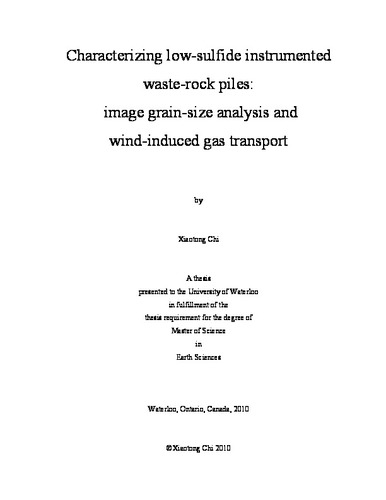| dc.description.abstract | This study is part of the Diavik Waste-Rock Pile Project taking place at the Diavik Diamond Mine in the Northwest Territories, Canada. The project involves the construction of three 15m-scale low sulfide test waste-rock piles and monitoring of fluid flow, geochemical reactions, heat and gas transport within the waste-rock piles and characterization of the physical properties of the waste-rock piles. The focus of this thesis is characterizing grain-size distribution of the waste-rock and quantifying gas transport in the test waste-rock piles.
Grain size of waste rock ranges from millimeters to meters. Sieve analysis typically only provides information of grain size <0.1 m at a single location. A computer program was developed using digital image-processing techniques to obtain a spatial grain-size distribution from photographs of tip faces of the test waste-rock piles acquired in the field. The program characterizes grain size >0.1 m and employs a region-growing algorithm for segmentation of waste-rock grains with pre- and post-processing techniques to improve the accuracy of segmentation. The program was applied to photographs of six different tip faces of the test waste-rock piles. For grain size <0.1 m, data from sieve analyses were attached to the grain-size curves generated from image grain-size analyses to obtain a full spectrum grain-size analyses ranging from boulders to fines. The results show that fine fractions are retained at the top of the tip faces and grain size increases non-linearly from top to bottom of a waste-rock pile. Calculations show that although the greatest mass is associated with the medium and coarse fractions, the greatest surface area is associated with the fine fractions. The results are consistent with field observation that the initial solute concentrations are greatest at the top of the pile and saturated hydraulic conductivity are lower at the top of the pile than in the pile interior. Statistical moments show that the test waste-rock piles have mean grain size of granules and are very poorly sorted, coarse skewed and leptokurtic. Permeability is calculated using empirical formulae and good agreement is obtained between calculated values and field measurements. The heterogeneity of grain size obtained from this study can provide a basis for future modeling efforts.
Gas transport analysis focused on 1) substantiating the relationship between wind flow external to the waste-rock pile and gas pressures within the pile, 2) determining the gas flow regime in the pile, and 3) quantifying the temporal variation in wind speed and direction and determining the relevant time scales. Differential gas pressures were measured in 2008 at 49 locations within one of the three test waste-rock piles and 14 locations on the surface of the pile at one-minute intervals. Wind speed and direction were measured at 10-min intervals. Correlations between wind vectors and pressure measurements show that the wind influences pressure fluctuations in the test pile. The strength of the correlation is roughly inversely proportional to the distance between measurement ports and the atmospheric boundary. The linear relationship between internal pressure measurements and surface pressure measurements demonstrate that gas flow is Darcian within the test waste-rock pile. Spectral analysis of wind data and a one-dimensional analytical solution to the flow equations show that the persistence of wind in a certain direction has most pronounced effects on transient gas flow within the pile. The penetration depth of wind-induced gas pressure wave is a function of the periodicity of the wind and permeability of the waste-rock pile. | en |

